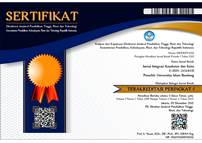Efek Antibakteri Ekstrak Akuades Buah Kurma (Phoenix dactylifera L.) Varietas Ajwa terhadap Staphylococcus aureus Secara In Vitro
Abstract
Penemuan antimikrob menjadi hal yang sangat penting dalam pengobatan dan kemajuan medis. Tantangan dalam pengobatan menggunakan antibiotik adalah resistensi bakteri terhadap antibiotik yang digunakan. Salah satu bakteri yang mengalami resistensi adalah Staphylococcus aureus. Oleh karena itu, diteliti alternatif pengobatan dengan menggunakan tumbuhan yang berpotensi memiliki kemampuan antibakteri. Buah kurma varietas Ajwa telah diteliti memiliki beberapa senyawa aktif yang berpotensi sebagai antibakteri dan antioksidan. Kurma Ajwa juga telah disebutkan di dalam Al-Quran dan Al-Hadits. Tujuan penelitian ini adalah mengetahui efek antibakteri ekstrak akuades buah kurma Ajwa dengan melihat luas zona hambat serta konsentrasi hambat minimum (KHM) dan konsentrasi bunuh minimum (KBM) pada Staphylococcus aureus. Penelitian ini menggunakan metode ekperimental secara in vitro dan bersifat deskriptif observasional dengan pendekatan kuantitatif. Metode yang digunakan adalah metode difusi dengan menggunakan sumuran dan metode dilusi padat. Penelitian ini dilakukan di Laboratorium Terpadu Mikrobiologi Poltekkes Bandung. Didapatkan rerata hasil zona hambat adalah 5,87 mm yang termasuk kategori sedang, KHM pada konsentrasi 50%, dan KBM belum dapat ditemukan. Berdasar atas uji statistik, hasil penelitian uji difusi menunjukkan bahwa ekstrak akuades buah kurma (Phoenix dactylifera L.) varietas Ajwa berpengaruh menghambat pertumbuhan bakteri Staphylococcus aureus.
ANTIBACTERIAL EFFECT OF EXTRACT AQUADES AJWA DATE (PHOENIX DACTYLIFERA L.) AGAINST STAPHYLOCOCCUS AUREUS IN VITRO
The discovery of antimicrobials has been significantly important for current treatments and the future developments in the medical field. One of the challenges faced in the usage of antibiotics is the resistance imposed by the bacteria towards the antibiotics itself. An example of such bacteria that experiences thisresistance is Staphylococcus aureus. As a result, studies regarding alternatives of treatments, specifically those utilizing various plants that may potentially have antibacterial properties are conducted. Previous studies have already shown that date palms of the Ajwa variety, known as Phoenix dactylifera, contains several active compounds that are potential antioxidants and exhibit antibacterial properties. The Ajwa date palm has also been mentioned in several scriptures of the Al-Quran and Al-Hadits. The objective of this study was to understand the antibacterial properties of aquadest-extracted Phoenix dactylifera through the measurement of the area of the zone of inhibition, the minimum inhibitory concentration (MIC), and the minimum bactericidal concentration (MBC) of Staphylococcus aureus. This study involves the use of an experimental method, known as in vitro, and is also a descriptive observational study with a quantitative approach. The methodology used consists of the well diffusion method and the solid dilution method. This study was conducted at Laboratorium Terpadu Mikrobiologi Poltekkes Bandung. The results of this study show an average zone of inhibition of 5.87 mm which is categorized as medium, a minimum inhibitory concentration of 50%, and a minimum bactericidal concentration that is yet to be found. Based on statistical tests, the result of the diffusion method shows that the aquadest-extracted Phoenix dactylifera is influential in inhibiting the growth of the Staphylococcus aureus bacteria.
Keywords
Full Text:
PDFReferences
WHO. High levels of antibiotic resistance found worldwide, new data shows [Internet]. WHO. World Health Organization; 2018 [dikutip 24 Februari 2019]. Tersedia dari: https://www.who.int/mediacentre/news/releases/2018/antibioticresistance-found/en/.
Luepke KH, Suda KJ, Boucher H, Russo RL, Bonney MW, Hunt TD, et al. past, present, and future of antibacterial economics: increasing bacterial resistance, limited antibiotic pipeline, and societal implications. Pharmacother J Hum Pharmacol Drug Ther. 2017;37(1):71–84.
Esposito S, Leonardo T, Macchini F, Bianchini S, Biffi G, Vigano M, et al. Staphylococcus aureus colonization and risk of surgical site infection in children undergoing clean elective surgery. Med (United States) [Internet]. 2018;97(27):1–4. Tersedia pada: http://journals.lww.com/mdjournal%0Ahttp://ovidsp.ovid.com/ovidweb.cgi?T=JS&PAGE=reference&D=emexb&NEWS=N&AN=623124868.
Sjahril R, Agus R. Deteksi Methicillin Resistant Staphylococcus aureus (MRSA) Pada Pasien Rumah Sakit Universitas Hasanuddin Dengan Metode Kultur. 2018;(April):15–21.
Martín-Sánchez AM, Cherif S, Ben-Abda J, Barber-Vallés X, Pérez- Álvarez JÁ, Sayas-Barberá E. Phytochemicals in date coproducts and their antioxidant activity. Food Chem. 2014;158:513–20.
M S, Abdulkadir F, Salim F., Abubakar M, Kutama A. Date palm (Phoenix dactylifera) as food supplement and antimicrobial Agent in the 21 st Century-A review * 1 Sani M. IOSR J Pharm Biol Sci. 2016;11(4):46–51.
El-Sohaimy S a, Abdelwahab a E, Brennan CS, Aboul-enein a M. Phenolic content, antioxidant and antimicrobial activities of Egyptian date palm (Phoenix dactylifera L.) fruits. Aust J Basic Appl Sci. 2015;9(1):141–8.
Abdillah M, Nazilah NRK, Agustina E. Identifikasi senyawa aktif dalam ekstrak metanol daging buah kurma jenis ajwa (Phoenix dactylvera L.). In: Prosiding Seminar Nasional III Tahun 2017 [Internet]. Malang: Universitas Muhammadiyah; 2017. hal. 69–74. Tersedia pada: http://researchreport. umm.ac.id/index.php/69.
Hanggita Rachmawati S, Dwita Lestari S. Pengujian aktivitas antioksidan ekstrak bunga lotus (Nelumbo nucifera). Fishtech [Internet]. 2014 [dikutip 25 Februari 2019];3(1). Tersedia pada: http://www.thi.fp.unsri.ac.id.
Fardhayanti DS, Riski RD. Pemungutan brazilin dari kayu secang (Caesalpinia sappan L) dengan metode maserasi dan aplikasinya untuk pewarnaan kain. JBAT. 2015;4(1):6–13.
Greenwood D, Slack RC, Barer MR IW. Medical Microbiology: A Guide to Microbial Infections: Pathogenesis, Immunity, Laboratory Diagnosis and Control. 18 ed. Elsevier Health Sciences; 2012.
Lingga AR, Pato U, Rossi E, Teknologi J, Fakultas P. Uji Antibakteri Ekstrak Batang Kecombrang (Nicolaia speciosa Horan) terhadap Staphylococcus aureus dan Escherichia coli. JOM Faperta. 2016;3(1).
Caroll K. Jawetz, Melnick, & Adelberg’s Medical Microbiology. 27 ed. McGraw-Hill; 2016.
Septiani S, Dewi EN, Wijayanti I. Aktivitas Antibakteri Ekstrak Lamun (Cymodocea rotundata) Terhadap Bakteri Staphylococcus aureus dan Escherichia coli. SAINTEK Perikan Indones J Fish Sci Technol. 2017;13(1):1.
DOI: https://doi.org/10.29313/jiks.v2i2.5769
Refbacks
- There are currently no refbacks.
Jurnal Integrasi Kesehatan dan Sains is licensed under a Creative Commons Attribution-NonCommercial-ShareAlike 4.0 International License.







.png)
_(1).png)




















